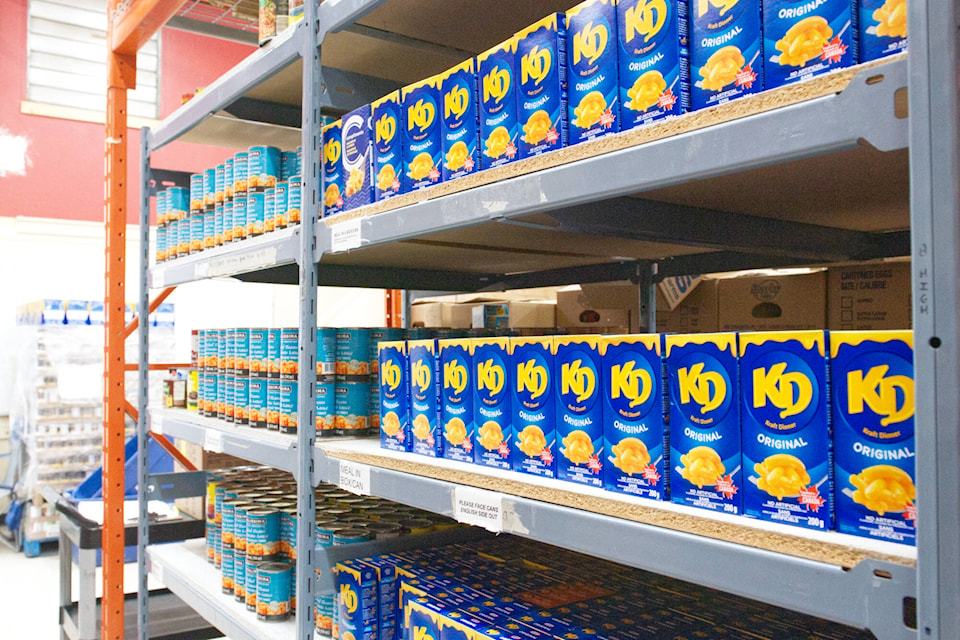“Foresight is not about predicting the future; it’s about minimizing surprise.”
These are the words of Canadian futurist and science fiction writer Karl Schroeder. While they serve as a poignant philosophical musing, they almost perfectly apply to a recent research project by Yukon University business administration students.
For their analytical statistics class, Matthew Mason, Mehakdeep Kaur and Sagar Wadhwa decided to take a crack at forecasting the demand for hampers at the Whitehorse Food Bank. Their findings indicate that demand for the food bank’s services is expected to rise in the first nine months of 2024 compared to the same period last year.
“We were looking at forecasting for the demand of hampers, try to help them kind of predict what their usage will look like. So, we looked at different economic factors — consumer price index factors, unemployment, some other factors like that, to see if we could find a correlation between changes in those factors and the demand for hampers,” Mason tells the News.
The student’s forecast model indicates that 3,417 hampers will be given out by the food bank in Whitehorse in the first quarter of this year, up from 3,101 in 2023. In the second and third quarters of 2024, it is forecast that 3,487 and 3,284 hampers will be given out in the city, compared with 3,167 and 2,856 during the same quarters in 2023.
In their conclusions, the students note that nearly 56 per cent of the variation in hamper demand at the food bank in Whitehorse “is possibly explained” by changes in food costs. Meanwhile, roughly 60 per cent of variation in hamper demand could possibly be attributed to changes in the cost of housing.
The student’s study compared nearly two and a half years of food hamper data to macroeconomic factors to detect trends that could assist the Whitehorse Food Bank in preparing for future demand. The hamper data was provided by the Whitehorse Food Bank and covered the months from April 2021 to September 2023.
According to the methodology section of the student’s final report, 10 independent factors — provided by the Bank of Canada and Statistics Canada — were included in the initial data collection. These variables included changes in consumer price index data for housing, food, transportation, energy and alcohol, tobacco and cannabis products, among others. Changes in the Bank of Canada’s base interest rate, unemployment and population were also considered.
Ultimately, the number of independent variables was reduced to three — changes in the cost of food and shelter and fluctuations in the unemployment rate.
Mason says the team decided to reduce the number of variable factors due to the complexity of how the initial 10 factors interacted. The student research team also adjusted their forecast to account for seasonal fluctuations in demand.
“We tried to simplify it, and we went with basic needs: food and shelter. Clearly, food because we’re talking about the food bank and shelter because, you know, rent is what it is in this town, and everyone needs it — somebody’s got to pay for where they live, and it’s one of the most expensive things. And then we wanted to see how it worked with unemployment, which was a little interesting because it didn’t quite work the way we expected,” Mason says.
The role of unemployment in the trio’s research is particularly fascinating because it seemingly defies logic. One would be forgiven for assuming that demand for food bank hampers would increase as the unemployment rate rises. However, the student’s forecast model indicates quite the opposite: For every one per cent rise in unemployment, hamper demand decreased by 28 hampers, when other variables are held constant.
The reasons behind this counter-intuitive finding remain unclear, and Kaur admits the students were “fully shocked” by their model’s forecast concerning unemployment and hamper demand.
The trio of students have theories, though. Kaur notes that the data could be “wonky” due to the fact it came from a time when the COVID-19 pandemic was still impacting employment, while Mason suggests there could be a delay between when someone loses their job and when their finances reach a point that they need to turn to the food bank for support.
Theories aside, the trio of students agrees that more research — and more data — is required to fully understand the relationship between unemployment and food bank services.
“We discussed with the team as well, like, other things are happening. There could be other factors that are affecting unemployment. So, maybe someone needs to go deeper. We just didn’t have time in our three-month project,” Kaur says.

Working with the Food Bank Society of the Yukon, which runs Whitehorse’s food bank, was a natural choice, according to Mason, as Kaur and Wadhwa were already working on a project with the food bank for another class.
Aiding the food bank also held personal meaning to Mason, who’d had to briefly access the food bank’s services over a decade ago while he was out of work.
“I had a stretch of about four months back in 2012 that I was unemployed, and I had to use the food bank. I had little boys at home — I just needed to make sure we had food on the table. It was a temporary thing, as it is for a lot of people – there’s no shame in that,” Mason tells the News.
He adds, “So for me, I feel a lot of personal benefit to kind of pay that back to them, right? Like I’ve given them something that helps them to reduce waste and plan better, which then allows them to help the people that may need it next.”
Upon completing their statistics project, for which they earned an A grade, the trio presented their findings to the directors from the Food Bank Society of the Yukon.
“When you are presenting in front of your class, you’re comfortable with them. But then you’re presenting in front of directors after — directors from the food bank — and that was kind of, like, a nervous [experience],” Kaur says before Mason chimes in, “But they were very warm and welcoming, though. It was a very fun experience.”
The trio hopes the food bank can utilize their forecast model’s findings to plan ahead and avoid unexpected surges in hamper demand. Kaur also notes that the forecast model could help the food bank’s staff predict how many volunteers they’ll need in a given season or when fundraising will be necessary.
“Building hampers takes a lot of time, so if the food bank already knows what they’ll need, they can build it way ahead of time, right?” Wadhwa says.
Speaking to the News in January, Dave Blottner, executive director of the Food Bank Society of the Yukon, hailed the stats students’ forecast model. He also indicated its findings are in line with what his team is experiencing on the ground.
“It’s a great project with the Yukon University, although it has a bleak outlook because it says we’re going to see more people coming through the door. And honestly, that’s the instinct anyway — things aren’t getting easier right now,” Blottner says.
Contact Matthew Bossons at matthew.bossons@yukon-news.com
